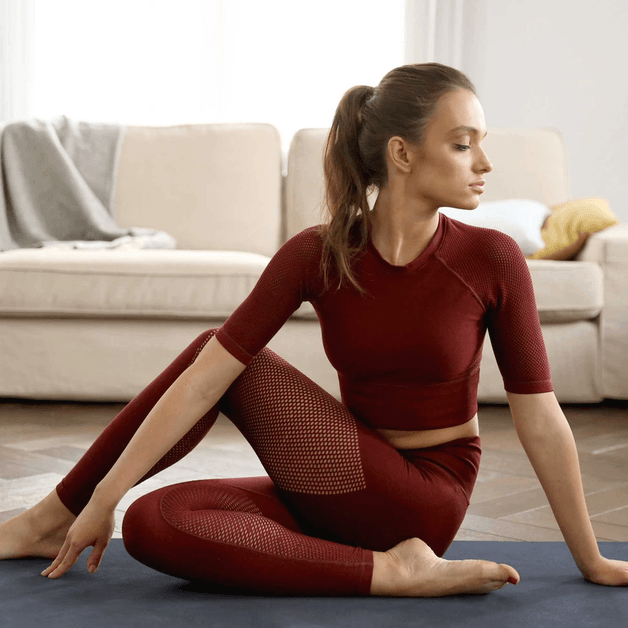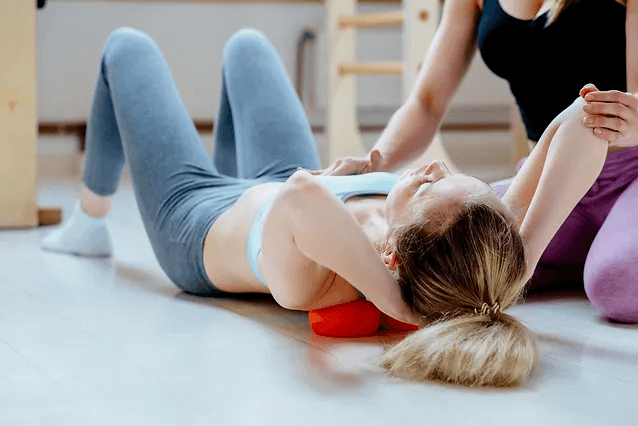Pilates – what are the benefits and why join me as a clinical pilates practitioner?
Up to 90% of the population suffers low back pain at some point. Many recover within six weeks. A study has estimated that chronic low back pain occurs in 85-90% of patients, meaning that pain has lasted longer than 12 weeks. After that, a cycle of Move – It Hurts – Stop Moving can ensue. Finding the proper movement at the correct level for each individual is often crucial to complete recovery or learning to manage pain.
I often hear, “movement is medicine.” I agree; however, I do not want to reinforce a poor movement pattern that might increase pain or add stress to a weak point.
Why choose Pilates exercise as a movement modality to improve your quality of life if you have low back pain?
Below are reports from a few of my client about pilates and low back pain
“I first came to Fiona’s classes in early 2019 after moving to the area. I’d done Pilates for several years before this. Then I had a back injury and was later diagnosed with arthritis in one of my facet joints. I have also fractured both wrists in the last four years and have osteoporosis. This means that traditional pilates exercises, such as those taught in a general class, are no longer all appropriate for me. I need to be aware of what movements may aggravate my body. It also means strengthening my core and other muscles to reduce re-injury risk.
What I have found helpful about Fi’s classes is that she explains to us how the various parts of the body work (she loves anatomy!) and how movement at one point of the body can impact other points in both negative and positive ways. Under a trained instructor like Fiona, we can learn to understand our bodies and follow a more tailored programme to gain optimum benefits. But with increased body awareness and awareness of our body’s anatomy, it helps to understand which pilates exercises benefit me.
This more “modified” form of Pilates is customised to my injury, weight, health issues, and body type, thus better aiding rehabilitation and functional movement and reducing the risk of aggravation or re-injury.
It’s been a win-win experience for me.” Sue

The Pilates Principles are a good starting point.
Breath: is essential to life and often dysfunctional in those with back pain, anxiety and pelvic floor problems. Improved breathing helps activate the muscles that support your spine and pelvis.
Concentration: you need to focus, bringing your attention to your body, and breathing can be deeply relaxing and calming. As you relax, the tension in the tissue reduces and can help reduce pain.
You may start your pilates journey as unconsciously incompetent as you become aware of your body during movements you become consciously incompetent. However, mastering the movements and breathing leads to unconscious competence; you can enjoy all movements and know that they nourish your body.
Centring: Traditionally, in Pilates, a familiar cue is to hollow or scoop the abdominals. Improved breathing and becoming aware of your midsection rather than cueing the core should help you strengthen and connect to your core. The diaphragm, deep abdominal muscles, spinal muscles, and pelvic floor need synergy. Coordination and balanced tone and activation help stabilise the spine and pelvis.
Control: Control of how the body moves develop better movement strategies that are less stressful to joints and make daily activities and exercise more efficient and enjoyable.
Precision: Moving from the right place. Quality over quantity. It is not about the perfect exercise; it is, however, essential for you to teach your body to move optimally for you. Being precise and repeating movements re-educates.
Flow: Easy and effortless movement. Fluidity, using just enough effort to complete the exercise and keeping the movement smooth.
And the research…….
A 2021 study – Pilates-based core exercise improves health-related quality of life in people living with chronic low back pain – Concluded, Pilates should be considered as a valuable and safe non-pharmacological intervention to improve well-being in those with chronic low back pain.
A study completed in 2019 – Application of Pilates-based exercises in the treatment of chronic non-specific low back pain: state of the art –
suggests pilates exercise offers greater improvements in pain intensity and functional ability compared with usual care and physical activity.
They agreed that Pilates would benefit those with poor movement patterns, lack of body awareness, and poor breathing patterns. In addition, Pilates should be indicated for those with poor postural control, reduced lumbar spine mobility and weak stabilising muscles of the lumbar spine.
2x sessions weekly seem to be better than once a week and provide clinically important improvements. However, 3x sessions per week did not influence decreasing pain and disability.
Modified Pilates?
Research Article 2020: Effects of Modified Pilates Exercises on Pain, Disability, and Lumboplevic Motor Control in Patients with Chronic Low Back Pain – Concludes that modified pilates exercises effectively increased the level of muscle endurance and the control of lumbopelvic motion, and reduced pain and disability.

“I have been attending Fiona’s classes for at least 15 years. Since lockdown classes are done live through zoom, being in the comfort of my own home, I can attend a selection of classes according to my work schedule. In addition to clinical Pilates, I do Hypopressive and Pelvic Floor Health. The combination of the three gives me a complete understanding of how strengthening my core protects my back. I have better posture, balance and blood circulation. My waist muscles are slim and strong, and my pelvic floor muscles are back to pre-children. Pilates sessions are regularly changing, so all my body parts get to work out gently but deeply. Sessions are live; you have to be on time; no excuses to postpone your wellness exercises for another hour or tomorrow….” Martine

Equipment vs Mat-based Pilates –
Both are beneficial. Using equipment provides more stimulus to the system. The more you feed the sensory system, the stronger and more stable you will become, and the better the body will adapt and respond in everyday life. We use small equipment in our zoom sessions, poles, soft pilates balls, bands, the spine corrector or hog, and prickle pods and balls.
Why join me? I am a clinical pilates practitioner with over 20 years of experience. I love anatomy, and I have honed my skills over the years. I continue to develop my classes and work in line with current research. I use many tools from my box, touch as a soft tissue therapist, pelvic floor health, and breath work with hypopressives. Educating clients about the body and movement has improved results and given them the knowledge and confidence to play with movement and try different sports to find things they enjoy.
“I had been attending a Chiropractor for lower back pain and disc problems. He suspected disc herniation. He recommended that I try modified pilates as he felt that it could help strengthen my core and stabilise my back.
Since joining classes I can honestly say my back feels so much stronger and more stable than it has in years. I can now move more freely, I feel my posture has improved and the pain in my back and buttock are hardly noticeable. The numbness in my leg has disappeared.
I now have confidence that my back is stronger. I was able to ride motorcycle pillion through Europe without problem, something I would have struggled with before joining pilates.” Sue
The right class for you at the right time, Pilates is not the correct place to start if you have a particular problem.
“I went to the doctor about 18 months ago with what had become a very evident prolapse. He talked through the possible treatments, which were fitting a pessary or surgery if that failed, although he said he would only consider that as a last resort.
In the meantime, I contacted Fi about starting Pilates with her. However, at a 121 meeting with her, when I mentioned the prolapse, she immediately said that Pilates might not be the best thing for me initially but had I considered Hypopressives and Pelvic Floor Specific sessions. Of course, Hypo what? Was my immediate reaction!
I started regular zoom sessions with her and haven’t looked back. However, it wasn’t an instant ‘cure’ by any means, and it took around three months before I could honestly say I felt anything. Nevertheless, encouragement from other group class members kept me persisting with the sessions. Now almost a year down the line, I can achieve good vacuums and feel that everything has lifted, and stress incontinence is much reduced. I have also been doing pelvic floor exercises online with Fi, reinforcing the benefit.
My original GP has retired, and I now have a female GP I thought might be more in tune with pelvic health issues; this has not been the case. She had never heard of Hypopressives. Self-help seems to be the way forward, and keep promoting your cause on behalf of all of us.” Kate
Research Article 2020 – Effectiveness of Hypopressive Exercises in Women with Pelvic Floor Dysfunction: A Randomised Controlled Trial – doi:10.13390/jcm9041149 – Concludes Multi-modal physiotherapy treatments based on Pelvic Floor Muscle Training, Hypopressive Exercise, or both and all including an educational programme, the knack and home exercises, significantly reduced pelvic floor dysfunction symptoms and enhanced quality of life and improved pelvic floor muscle strength and tone among women with combinations of mild symptoms of pelvic floor dysfunction, including stress or mixed urinary incontinence, anal incontinence or pelvic organ prolapse (stages I-II)
Research Article 2022 – Are hypopressive and other programs effective for the treatment of pelvic organ prolapse? – https://doi.org/10.1007/s00192-022-05407-y
Concludes – Pelvic Floor Muscle Training remains the first-line treatment for pelvic organ prolapse.
My mission is “To find the best modality and practitioner for each client, and to give every client back the ability to take control of their body through education, touch, movement re-patterning and awareness”. We are all individuals, and a client’s overall health and well-being remain central. I may refer out. I suggest a combination of things; we work this out together.
You can join daily zoom sessions for Pilates, hypopressives and pelvic floor health for one inclusive four weekly fee: no joining fee, no fuel costs, no parking or childcare struggles.
I am an Anatomy Trains Structural Integration Practioner and one of the Anatomy Trains Teachers. In addition, I have a background in Soft Tissue Release and Sports Massage. I have been in the Pilates Industry since 2000, initially completing my training with Modern Pilates and Chris Norris. I became fully certified with the Australian Pilates and Physiotherapy Institute in 2006, completing mat and equipment training. Many of my clients have low back issues, and I am a certified level 4 Pilates for low back pain practitioner. Pelvic Health from a global lens is my passion. My colleague Julie Hammond and I have developed a workshop, Balancing the Diaphragms, to teach movement professionals and manual therapists to treat pelvic health from a global lens. In addition, I am a certified Exercise for Pelvic Floor dysfunction therapist.
